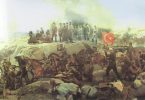The Protestants under threat in Europe in the 16th century, took asylum in Ottoman territory. Many Christians took refuge in Budin, and were able to freely practice their religions.
Contributor: Prof. Dr. Erhan Afyoncu
 The Ottomans supported the Protestants and Calvinists at every opportunity. In 1552, Suleiman the Magnificent wrote in a letter sent to Protestant German princes that he was to embark on a campaign to that region soon, but that they would not suffer any damage from the Ottoman military operations, and provoked them against the Pope and Charles V. The Ottomans followed the Calvinist activity although not as closely as Luther and his followers. Three years after Calvin’s death, the bravery of the Calvinists who fought in Saint-Denis under the command of Prince Condé in white cloaks and sweaters was praised in a letter sent from Turkey. In this letter, the Ottoman sultan says: “If those who wore white were under my command, I would occupy the world and nobody could have kept me from that”.
The Ottomans supported the Protestants and Calvinists at every opportunity. In 1552, Suleiman the Magnificent wrote in a letter sent to Protestant German princes that he was to embark on a campaign to that region soon, but that they would not suffer any damage from the Ottoman military operations, and provoked them against the Pope and Charles V. The Ottomans followed the Calvinist activity although not as closely as Luther and his followers. Three years after Calvin’s death, the bravery of the Calvinists who fought in Saint-Denis under the command of Prince Condé in white cloaks and sweaters was praised in a letter sent from Turkey. In this letter, the Ottoman sultan says: “If those who wore white were under my command, I would occupy the world and nobody could have kept me from that”.
The Protestants under threat in Europe, took refuge in Ottoman territory. Transylvania under the Ottoman rule was the primary refuge for Calvinists and Unitarians. Many Protestants took refuge in Budin, and freely practiced their religion. As a matter of fact, Sigmund Torda who was a Protestant of Hungarian origin, wrote a letter to one of the leading Protestants in Germany, Philipp Melanchton in December 1545 and informed him that Protestantism was rapidly spreading in his country and that is why Ottoman invasion in Hungary was a blessing from God. Many letters were written to the Protestants in German principalities from Hungarian territory under Ottoman rule, in which people expressed how they could safely practice their religion. The letter Emerius Zigerius (Imre Eszeki) who lived in Hungary sent to a prominent Protestant in Germany, Matthias Flacius lllyricus, is one of the most interesting examples.
The letter in which Zigerius explains that “the Protestants in the Ottoman Empire practice their religion openly which is out of question in Christian Europe”, reached Flacius in June 1550, and Flacius published this poetic letter with a foreword. Flacius writes the following in the foreword: “I wanted our so-called Christian rulers to feel embarrassed upon hearing that the Turks defend the faithful servants of God, the Christians, and even allow them to openly spread and practice Christianity. It is not the Pope or the Spanish I am talking about. Although they recently adopted true Christianity, they deny it because they either fear the Catholics’ brute force or out of profit. They commit betrayal to completely expel the teachings of Jesus from Germany. They should follow in the footsteps of Turks. These so-called Christians treat true Christians worse than the Turks. Turks do not only tolerate the true Christian teachings, but also defend Christianity against the non-Christian wolves (Catholics) with their swords… I do not intend to cause a disturbance with this letter. My aim is to show the Christian church in Turkey as an example to followers of true Protestantism, and give them courage and hope. And to show the rulers who identify themselves as Christians the good intentions and softness of Turks, and perhaps to dissuade them from attacking and rage. ” This letter and other similar letters explained how Turks were kinder towards Protestants than Catholics which was used as a major propaganda tool.
Luther exaggerated Turkish threat in his works and sermons, and pursued the policy of focusing on the Ottomans by escaping Catholic oppression. So when Charles V and Ferdinand agreed on making a peace treaty with Turks in 1545, Luther strongly reacted. As a matter of fact, the House of Habsburg who had signed a year-long ceasefire with the Ottomans, first attacked the Protestants.
Charles V could not prevent Protestanism’s spread in German principalities due to Turkish attacks. In addition, the Habsburg needed Protestant troops to fend the Ottomans. Protestants required recognition of their religious beliefs to send soldiers to the front. With each Ottoman attack on the Holy Roman-German Empire, Protestantism became stronger and stronger, and eventually they won full recognition in Augsburg in 1555.
THE OTTOMAN HAND IN THE RISE OF MOSCOW
The policies Ottoman Empire pursued in the 15th century, was to cause great trouble ahead. The Moscow Knazestvo (Principality), a small city state of the period, was under Golden Horde control. Against the alliance of the Golden Horde with Poland-Lithuania, Moscow made an alliance with the Crimean Khanate under the Ottoman rule. The Ottoman Empire supported the alliance of Moscow Principality and Crimean Khanate because Poland-Lithuania threatened its position in Moldova and the Golden Horde made attempts to capture Crimea. After the Golden Horde State fell in 1502 by a blow dealt by Crimean Khan Mengli Giray, Moscow gained its independence and first seized other Russian principalities around it, followed by the Turkish khanates in the region up to Siberia and the Caucasus. The Moscow principalities had earned significant revenues thanks to the fur trade made with the Ottomans. The Ottoman-Russian friendship lasted until Ivan the Third captured the Golden Horde remains Kazan (1552) and Astrakhan (1556) in the Volga basin. Indirect support by the Ottoman Empire is an element that led to rise of the Great Russian Empire. Russia was influenced by the Ottoman army in the military organization during period of Ivan the Terrible in the 16th century. The discipline and merit system in the Ottoman army was taken as an example.
TURKISH TRACES FROM HUNGARY TO POLAND
The influence of the Ottoman army can be seen not only in Russia but also in various European states. The cavalry troops remained in the foreground in battles for a long time.









Leave a Comment